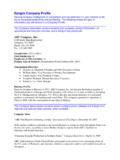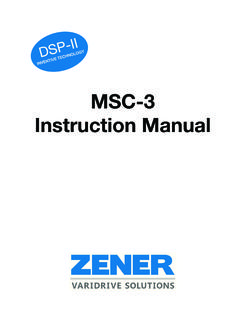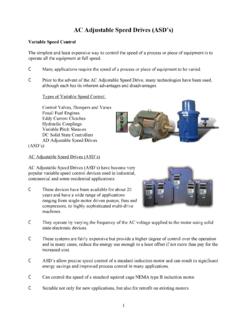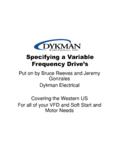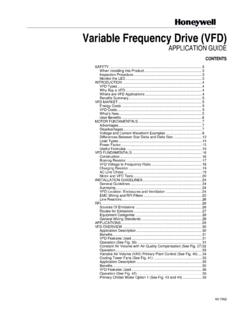Transcription of Variable Frequency Drives - Questline
1 Variable Frequency Drives INTRODUCTIONS Meet Your Panelists Mike Carter Mark Farrell 2 Contents Basics Motor Loads Operation Advantages/ Disadvantages Sizing a VFD Power Quality Issues Source: Emerson Industrial Automation VFD BASICS 3 Basics Work Applying a force over a distance Must result in movement W = F (lb) x D (ft) Example: Move 25 pounds a distance of 30 feet W = 25 lb x 30 ft = 750 lb-ft 25 lb 30' 4 VFD BASICS Basics Torque A force that produces rotation Torque exists even if no movement occurs T = F (lb) x D (ft) Example: A 60 pound force pushing a 3 foot lever arm F = 60 lb x 3 ft = 180 lb-ft 3' 60 lb Source: Stock Exchange 5 VFD BASICS Basics Horsepower (HP) A measure of the rate at which work is done 1 HP = 746 watts = 33,000 lb-ft/min = 550 lb-ft/sec Power (kW) = HP x Example.
2 What is electrical power for a 200 HP motor? Power (kW) = 200 HP x = 166 kW Source: 6 VFD BASICS Basics Electric motors Direction of current flow changes poles Source: Reliance Electric Source: Danfoss VFD BASICS 7 Basics Electric motors Stator field induces current flow in rotor conductors Source: Reliance Electric 8 VFD BASICS Basics Synchronous speed of rotating stator field Typically 5% slip for induction motors # Poles RPM 2 3,600 4 1,800 6 1,200 8 900 10 720 Source: Wenatchee High School Source.
3 Maxim Integrated Products 9 VFD BASICS Basics Motor torque Related to horsepower and speed T (lb-ft) = (HP x 5252)/rpm Example: A 30 HP motor operating at 1725 rpm T = (30 HP x 5252)/1725 rpm = 91 lb-ft Also related to voltage and Frequency Volts per hertz (V/Hz) Source: Baldor Electric 10 VFD BASICS Motor Loads Constant torque/ Variable HP Torque independent of speed. Not the best VFD application. Rotary/screw compressors Ball mills Conveyors Band saws Chippers Drills Lathes Load Motor Speed Torque and HP HP Torque MOTOR LOADS 11 Motor Loads Speed, Torque, and HP T = (HP x 5252)/rpm T HP/rpm rpm HP/T HP T x rpm Speed Torque HP 12 MOTOR LOADS Motor Loads Variable torque/ Variable HP Volume rpm T rpm2 HP rpm3 Compressors Centrifugal Pumps Blowers Fans Motor Speed Torque, HP, CFM Source.
4 Stock Exchange HP Torque CFM 13 13 MOTOR LOADS VFD Operation Synchronous speed of rotating stator field. Vary speed by varying Frequency Vary Frequency from 0 Hz to 60 Hz or more Source: Danfoss VFD OPERATION 14 VFD Operation Torque is proportional to volts divided by Frequency T V/Hz If you decrease Frequency , volts must decrease also to achieve constant torque Volts 60 Hz V/Hz Volts 30Hz 480 240 220 110 120 60 Source: The Crankshaft Knowledge Bank For more information on POLYPHASE INDUCTION MOTORS 15 VFD OPERATION VFD Operation Typical circuit diagram Adjustable Frequency drive (AFD) Variable Speed drive (VSD) Adjustable Speed drive (ASD) Source: 16 VFD OPERATION VFD Operation Constant voltage inverter Pulse width modulation ( to 15 kHz) Constant power factor High efficiency (up to 98%) Long ride-through Source.
5 Sebesta Blomberg & Associates 17 VFD OPERATION VFD Costs Rule of thumb is $200 to $500 per HP installed Example: 30 HP motor operating 5,000 hours annually costs $6,200 in electricity at $ Assume 50% energy savings at $3,000 VFD costs is 30 HP x $250/HP = $7,500 A little over a two year payback VFD COSTS 18 VFD Advantages Reduced power and energy Energy savings 25%-85% Improved power factor 95%+ Improved speed control VFD ADVANTAGES 19 VFD Advantages Increased reliability Decreased mechanical impact from soft-start Decreased maintenance costs Increased equipment life No need for throttles/dampers Built-in soft starting Source.
6 Emerson Industrial Automation 20 VFD ADVANTAGES VFD Energy Savings Power Input Flow Rate (%) Input Power (%) 10 10 20 30 40 50 60 70 80 90 100 20 30 40 50 60 70 80 90 100 110 120 130 140 Outlet Damper Inlet Guide Vanes Disc Throttle Ideal Fan Control Variable Pitch Axial Fan VFD Source: Emerson Industrial Automation VFD ENERGY SAVINGS 21 VFD Energy Savings Power Output HP rpm3 Example: speed reduction to 50% = HP1 x ( )3 = HP1 x *VT/VH = Variable Torque/ Variable Horsepower VT/VH Power vs Speed Speed Power 100% 100% 90% 73% 80% 51% 70% 34% 60% 22% 50% 13% 40% 6% 30% 3% 20% 1% 10% 22 VFD ENERGY SAVINGS VFD Energy Savings At 50% speed, VFD saves 75-85% versus output damping and Variable inlet speed control Control Motor HP Input vs Speed (100 HP)
7 25% 50% 75% Damper 50 73 93 Inlet Vane 44 60 73 VFD* 16 47 *Adjusted for part-load motor and drive efficiencies 23 VFD ENERGY SAVINGS VFD Energy Savings Assume a 25 HP fan motor operating 23 hrs/day Energy consumption VFD/Damping = = 50% 50% savings! VFD Pwr vs Speed @Hrs Speed Power Hours HP-Hr 100% 105% 2 75% 50% 8 67% 40% 8 50% 19% 5 Total Damping Pwr vs Speed @Hrs Speed Power Hours HP-Hr 100% 100% 2 2 75% 93% 8 67% 85% 8 50% 73% 5 Total 24 VFD ENERGY SAVINGS Soft-starting LRT I2 V2 Soft-start draws 400-600% of rated amps during motor start A VFD draws only 100% to 120% of rated amps at 100% rated torque Source.
8 Exponent Failure Analysis Associates Reduced Voltage Starter %V or %I %FLA %FLT 100 660 150 90 595 122 82 540 100 70 460 74 58 380 50 25 SOFT STARTING VFD Disadvantages Less efficient at 100% rated motor speed Possible winding insulation breakdown Inverter-rated motors recommended Harmonics Many possible preventive measures available Possible voltage reflected wave from long lead lengths Higher first cost Payback from lower energy consumption VFD DISADVANTAGES 26 VFD Best Applications All Variable torque applications Compressors Centrifugal Pumps Chilled water Condenser water Building supply Chemical dosing Blowers Fans Source: Emerson Industrial Automation VFD BEST APPLICATIONS 27 VFD Best Applications When pump and system curves are close to perpendicular Source.
9 Emerson Industrial Automation 28 VFD BEST APPLICATIONS VFD Best Applications Some constant torque applications Does improve the process Reduced speed operation in 50% to 75% range Current limited starting required Smooth acceleration required Source: Emerson Industrial Automation 29 VFD BEST APPLICATIONS VFD Best Applications When not to use VFDs Pump and system curves are parallel High lift Minimal pipe friction No variability in speed Use impeller trim Adjust the motor fixed speed (change gears) Pump operates efficiently ON/OFF Example: sump pump Source.
10 LLNL 30 VFD BEST APPLICATIONS Sizing a VFD Do not size the VFD based on horsepower ratings Define the operating profile of the load to which the VFD is to be applied Variable torque Must meet amperage rating of motor Constant torque Obtain the highest peak current readings under the worst conditions Check motor full-load amps (FLA) to see if the motor is already overloaded Starting torque modes High overload is 150% torque for one minute Breakaway torque allows 180% torque for seconds Normal overload is 110% torque for one minute Engage a VFD supplier for consultation SIZING A VFD 31 Sizing a VFD Determine why the load operation needs to be changed.
